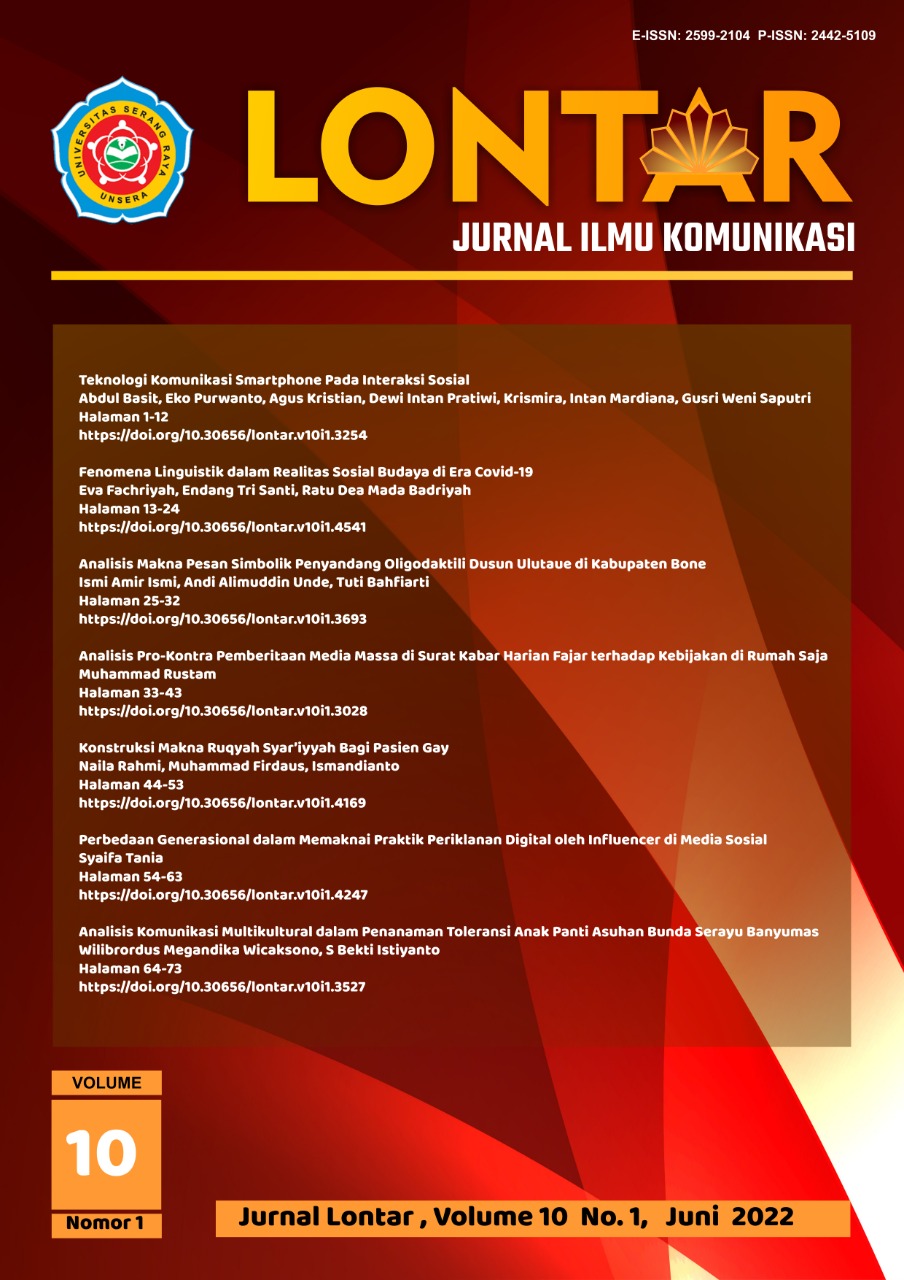Analisis Komunikasi Multikultural dalam Penanaman Toleransi Anak Panti Asuhan Bunda Serayu Banyumas
DOI:
https://doi.org/10.30656/lontar.v10i1.3527Keywords:
Tolerance, Communication Multicultural, OrphanageAbstract
Tolerance is still the homework in Indonesia. For the period 2008-2018, Wahid Foundation mentioned there were 1.420 violations by non-state actors and 1.033 violations by state actors related to intolerance. From this, the purpose of this study is to analyze early parenting in the context of multiculturalism at the Bunda Serayu Orphanage. The research uses the theory of symbolic interaction and the research method used is qualitative with narrative research. Data were collected through interview techniques, literature studies related to the stories of orphanage children, as well as observations at the orphanage. This orphanage takes care of children from various background. The result is caregivers instill a parenting pattern of equal affection for all. The differences that give rise to conflict are framed by egalitarian parenting patterns that characterize Banyumas culture. The encounter and interaction between children, caregivers, and peers at school and funder create to a new meaning of family. Visits to places of worship of other religions are also carried out as a means of getting to know the diversity. The multicultural communication creates to understanding, appreciation, and tolerance. This parenting pattern and visits to places of worship of other religions can be replicated to invest tolerance.
References
-, M. (2018). Kebijakan Komunikasi Multikultural Di Media Televisi Indonesia: Kontrol Pemerintah Terhadap Imperialisme Budaya. Jurnal Penelitian Komunikasi Dan Opini Publik, 22(1). https://doi.org/10.33299/jpkop.22.1.1303
Azmi, R., & Kumala, A. (2019). Multicultural Personality pada Toleransi Mahasiswa. TAZKIYA: Journal of Psychology, 7(1), 1–10. https://doi.org/10.15408/tazkiya.v7i1.13493
FarkaÄ, B., Scott, Z., & Å erek, J. (2020). Tolerance more than equality? Two facets of tolerance towards immigrants among Czech adolescents. European Journal of Developmental Psychology, 17(5), 679–703. https://doi.org/10.1080/17405629.2020.1724534
Fitriyani, A. (2018). FENOMENA KOMUNIKASI MULTIKULTURAL DI KOTA AMBON (Studi Pengalaman Komunikasi Antara Etnik Bugis dan Etnik Ambon). Jurnal Pemikiran Islam Dan Ilmu Sosial |, 11(01), 56–72.
Mondal, A. A. (2016). Articles of Faith: Freedom of Expression and Religious Freedom in Contemporary Multiculture. Islam and Christian-Muslim Relations, 27(1), 3–24. https://doi.org/10.1080/09596410.2015.1114240
Mulyana, D. (2018). Ilmu Komunikasi Suatu Pengantar. PT Remaja Rosdakarya.
Ningrum, N. (2012). Hubungan Antara Coping Strategy Dengan Kenakalan Pada Remaja Awal. Jurnal Psikologi Tabularasa, 7(1), 481–489.
Pransiska, T. (2020). Model Pendidikan Multikultural Di Panti Asuhan Mizan Amanah Yogyakarta: Prototip Pendidikan Ramah Anak. EDUKASI: Jurnal Penelitian Pendidikan Agama Dan Keagamaan, 18(1), 70–83. https://doi.org/10.32729/edukasi.v18i1.596
Puspitasari, M., & Istyanto, S. B. (2020). Perayaan Undhuh-Undhuh di GKJ Purwokerto sebagai Media Komunikasi Multikultural dalam Membangun Kerukunan. 9(1), 1–18.
Ragnarsdóttir, H., Jónsdóttir, H., Gunnarsson, G. J., & Finnbogason, G. E. (2020). Diversity, Religion and Tolerance: Young Adults’ Views on Cultural and Religious Diversity in a Multicultural Society in Iceland. Religion and Education, 47(4), 3–25. https://doi.org/10.1080/15507394.2020.1828233
Ri’aeni, I. (2019). Pengaruh Budaya Korea (K-Pop) Terhadap Remaja Di Kota Cirebon. In Communications (Vol. 1, Issue 1, pp. 1–25). https://doi.org/10.21009/communications.1.1.1
Santoso, E. & S. M. (2012). Teori Komunikasi. Graha Ilmu.
Sihombing, A. A. (2018). Mengenal Budaya Batak Toba Melalui Falsafah “Dalihan Na Tolu†(Perspektif Kohesi dan Kerukunan). Jurnal Lektur Keagamaan, 16(2), 347–371. https://doi.org/10.31291/jlk.v16i2.553
Sugiyono. (2016). Metode Penelitian Kuantitatif, Kualitatif dan R & D. Penerbit Alfabeta.
Suleman, F. (2017). Keberagaman Budaya dan Agama di Kota Manado. Endogami: Jurnal Ilmiah Kajian Antropologi, 1(1), 55. https://doi.org/10.14710/endogami.1.1.55-62
W.Creswell, J., & N.Poth, C. (2018). Qualitative Inguiry Research Design:Choosing Among Five Approaches. In Journal of Chemical Information and Modeling (Vol. 53, Issue 9).
Wicaksono, W. M. (2020). Di Tepi Serayu Aku Merindu. Penerbit Gramedia Pustaka Utama.
Widianingsih Rindha. (2019). Bahasa Ngapak dan Mentalitas Orang Banyumas : Tinjauan dari Perspektif Filsafat Bahasa Hans-Georg Gadamer. Jurnal Ultima Humaniora, II(March), 186–200. https://www.researchgate.net/publication/331976186_Bahasa_Ngapak_dan_Mentalitas_Orang_Banyumas_Tinjauan_dari_Perspektif_Filsafat_Bahasa_Hans-Georg_Gadamer_RINDHA_WIDYANINGSIH
Downloads
Published
Issue
Section
License
By submitting an article to the journal, the author(s) agree to transfer the published article's copyright to the journal, which will act as the publisher. This means the journal will have the right to publish the article in various forms, including reprints. The journal will maintain the publishing rights to the published articles.
In line with the license, authors and third parties (readers, researchers, and others) are allowed to share and adapt the material. In addition, the material must be given appropriate credit, provided with a link to the license, and indicated if changes were made. If authors remix, transform, or build upon the material, authors must distribute their contributions under the same license as the original.






